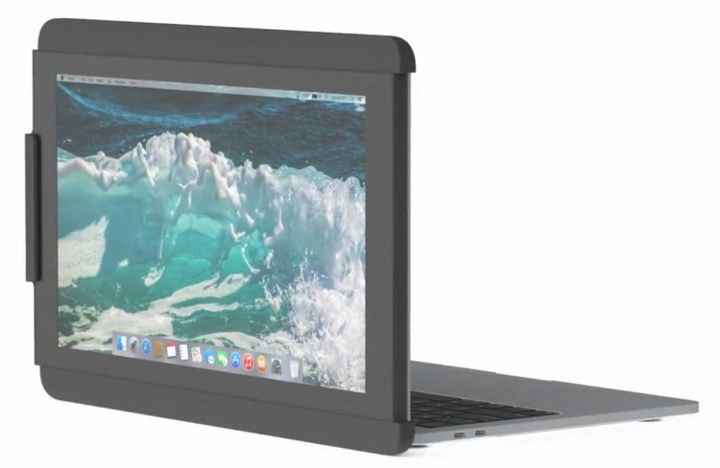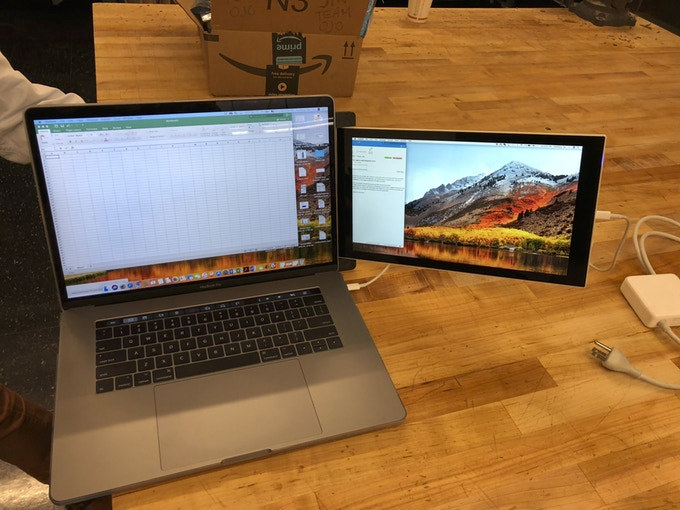I’m using a dual monitor setup at home since it’s just more convenient and increases productivity, but when I’m on the go, I have to revert to the single screen on my laptop.
The guys at Mobile Pixels decided it was not good enough, and worked on providing a solution that allows you to take that dual display setup on the go. This gave birth to DUO, a screen that attaches to the back of your laptop, and that you can slide to the left or right of your laptop’s screen to add another display whether you may happen to be.
- Display Size & Resolution – 12.5″, 1920×1080 pixels
- Rotation – 270º full rotation, 180° presentation mode
- Connection – USB type C for power and video signal
- Power Consumption – 1.6 Watts; 0.3W in “rest mode”.
- Dimensions – 32.5 x 21.8 x 1.2 cm (ABS plastic)
- Weight – 680 grams
A magnetic mounting system lets you attach the display to the lid of your laptop. You’ll also need to connect the display to one of your laptop’s USB ports, and it’s supposed to work with Windows, Linux, Mac, Android, and Chrome OS. It does not look to be using USB type C DisplayPort Alternate mode however, but probably relies on DisplayLink since there’s an adapter for standard USB port, and the company talks about Linux drivers being available.
https://www.kickstarter.com/projects/747287659/duo-the-on-the-go-dual-screen-laptop-monitor/description
You’ll find the product on Kickstarter, where they’ve raised over $80,000 so far, surpassing their $35,000 goal. Pledges starts at $169 for th Early Bird DUO with the display, a USB type C cable, a USB type C to USB type A adapter, and magnetic adhesives for two laptops. Shipping adds $14 to the US, $20 to the rest of the work, and you’d have to wait for January 2019 at least before receiving your reward.
 Via Liliputing
Via Liliputing

Jean-Luc started CNX Software in 2010 as a part-time endeavor, before quitting his job as a software engineering manager, and starting to write daily news, and reviews full time later in 2011.
Support CNX Software! Donate via cryptocurrencies, become a Patron on Patreon, or purchase goods on Amazon or Aliexpress






I use an asus display, just pack it and an easel in with the laptop. No problem with that.
There is a USB C 1080p external as well, but my cheepo laptops only have USB 3.
This is cute, but as expensive as mine, and smaller. I would not mind the 1080p.
Dell also has in my E laptop wireless second display and dock via Intel choose features, but I’ve not figured out the hardware for that yet.
Still has a standard dock as well.
Hm… Adding 0.6 Kg of weight to one side of laptop screen? Not really sure about that…
Really like the idea of an lcd that attaches to the laptop, but was surprised no one had thought of it before.. but it looks like it has. Packed Pixels had a similar Kickstarter campaign back in 2014… doesn’t seem like they ever delivered.
Slidenjoy was another kickstarter campaign, but they seem to be still around (yourslide). Hengedocks seems to be mac only.
Mainstream product: AOC mobile USB-C-Monitor I1601FWUX. Not hanging on the laptop lip, but with its own stand. Nice.
The AOC I1601FWUX is 15.6 inch … a bit large for my 14 inch laptop. Maybe there will be 14 inch variants too.
Anyway: so the display technology is already there, so the Kickstarter is only about the physical construction.
> the display technology is already there
Sure, it’s called DisplayLink and is a guarantee for problems and driver hassles. If you’re not using a recent Windows on your laptop you should read some reviews first.
An USB-C attached display using the DisplayPort Alternate Mode would be nice, but I would never ever buy something relying on DisplayLink!
Ubuntu here … https://support.displaylink.com/knowledgebase/articles/641668-known-issues-with-displaylink-ubuntu-support indeed shows quite a list of problems …
Oh, wait: is DisplayLink closed source software / driver? If so, I certainly won’t buy it.
Of course it’s closed source: https://support.displaylink.com/knowledgebase/articles/1104056-why-has-displaylink-not-released-source-code-for-t
It’s a proprietary technology to ‘capture’ the video on your host, then applying some compression (hello artefacts!) so send it through an USB link to a display driver board that decompresses the contents.
First and most basic requirement: you need a driver running on your host to do all of this. And since the driver is neither part of common operating systems nor available as source code being able to use your DisplayLink device might not be possible any more after you change anything to your software (e.g. doing an OS upgrade).